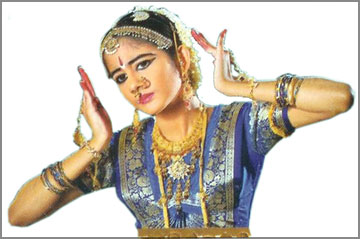Dance in everlasting inscriptions
Subashini Pathmanathan
Ancient world kept its inscriptions in stone and copperplates or
durable metals.
This was long before the paper and print appeared. These inscriptions
are mostly related to succession to the throne, endowments to religious,
educational bodies and records of political events such as victories and
sometimes even economic affairs. Endowments to temples were inscribed in
copperplates or stones.
|

Only talented and skilled could engage in dance |
Ancient Tamil dance grew up as temple art, and there are numerous
references in inscriptions to this art. We gather from these
inscriptions that these dancers were variously referred to as
Devar-Adiyar-kal, (handmaids of the Lord), Pathi-aye-yalar, those
ministering to the Lord. The temples’ professional dancers were called
kuthiyar. Those outstanding temple dancers were called veraliyar. The
veraliyar lived in a certain area called Verali Malai. To this day, it
is called Verali Malai.
Those who excelled in dance were awarded the title Thalai Koli. Even
now inscriptions can be found describing awards made such as
Ainooru-wath-Talai-Koli and Arangath-Thalai-Koli. All these clearly show
the enormous interest that the ruling houses took in the development of
temples and dances.
Some kings established colonies and settled female dancers in the
colonies. In the Thanjavur Rajajeswara Temple 400 female dancers were
settled. This is evidenced by stone inscriptions. The Chola emperor
Kulothunga III settled 200 female dancers in a colony called Thiru-
Puvna –Veeran-Pathi-Yiya-Lalar.
Some stone inscriptions bear witness to the fact there were male
dancers and dance teachers who were variously called Chakayer, Koothar,
Kootharasan, Nirutha Peraiyan, and Natuva Aasaan.
The lands endowed to these dancers were called Koothu Kaani, Nattuva
Kaani and Nattuva Puram. Stone inscriptions also reveal that the dances
were performed to suit the occasions. There are also references about
dancers, male and female, who excelled in the art.
|

Dance was held in high esteem |
In some cases, certain villages were given to the dancers. Even to
this day, one village is called Kootha Nallur. These inscriptions show
the high esteem, in which the dancers were held by the ruling monarch.
The Chola emperor Raja Raja Chola III witnessed the performances of
the dancer Ura-Waa- Kinan Thalai Koli. He renamed the adjoining village
in the name of the dancer as a tribute to her excellence.
Stone inscriptions also show Nirutham and Nirthyam were held in high
esteem. Those who showed outstanding talent in Nirutham (pure dance)
were called Nirutham Peraiyan. Another stone inscription reveals that
the dancers installed statues, and performed dances, before the statues.
One such person referred to as Umiyal-Sathira-Vida Nankayar who on the
day of Thiruvathiri constellation in the month of Vikasi (May),
installed a statue and danced before it. The references in inscriptions
and matters pertaining to dances are far too numerous.
From the inscriptions we also gather that titles were conferred by
the reigning monarch on the outstanding male dancers. Nattuva-
Kulothunga-Chola- Nirutha Peraiyan, Thiru-Votari- Chakai- Momudi Chola
Nirutha Peraiyan. Some touring dancers were granted the privilege of
having the details of the dancers inscribed in stone.
In the 18th year of the reign of Kanna Devan, one stone inscription
was made, stating the details of the dances performed during the
procession of the deities.
Dance halls were constructed and properly managed. Many other details
were set out in stone inscriptions. Stone inscriptions also reveal that
in the Thiru-Vaduthurai-temple that a dance hall existed. Likewise, in
Kachi Ekampara Natha Temple a Nirutha Mandapam was erected.
Inscription revealed that a sathir Mandapam existed, in the ninth
year of the reign of the first Raja Raja Cholan established a Sathir
Chalai (a dance hall).
During the reign of the ancient kings dance occupied an important
place. |



